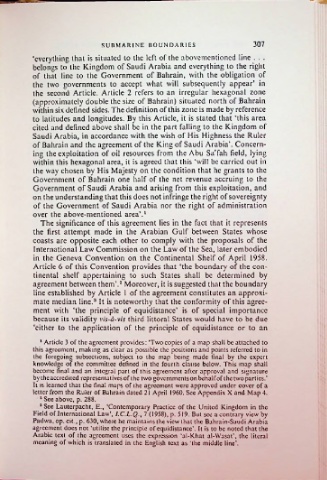Page 371 - The Arabian Gulf States_Neat
P. 371
*•* ..
SUBMARINE BOUNDARIES 307
‘everything that is situated to the left of the abovementioned line . . .
belongs to the Kingdom of Saudi Arabia and everything to the right
of that line to the Government of Bahrain, with the obligation of
the two governments to accept what will subsequently appear’ in
the second Article. Article 2 refers to an irregular hexagonal zone
(approximately double the size of Bahrain) situated north of Bahrain
within six defined sides. The definition of this zone is made by reference
to latitudes and longitudes. By this Article, it is stated that ‘this area
cited and defined above shall be in the part falling to the Kingdom of
Saudi Arabia, in accordance with the wish of His Highness the Ruler
of Bahrain and the agreement of the King of Saudi Arabia’. Concern
ing the exploitation of oil resources from the Abu Sa'fah field, lying
within this hexagonal area, it is agreed that this ‘will be carried out in
the way chosen by His Majesty on the condition that he grants to the
Government of Bahrain one half of the net revenue accruing to the
Government of Saudi Arabia and arising from this exploitation, and
on the understanding that this does not infringe the right of sovereignty
of the Government of Saudi Arabia nor the right of administration
over the above-mentioned area’.1
The significance of this agreement lies in the fact that it represents
the first attempt made in the Arabian Gulf between States whose
coasts are opposite each other to comply with the proposals of the
International Law Commission on the Law of the Sea, later embodied
in the Geneva Convention on the Continental Shelf of April 1958.
Article 6 of this Convention provides that ‘the boundary of the con
tinental shelf appertaining to such States shall be determined by
agreement between them’.2 Moreover, it is suggested that the boundary
line established by Article 1 of the agreement constitutes an approxi
mate median line.3 It is noteworthy that the conformity of this agree
ment with ‘the principle of equidistance’ is of special importance
because its validity vis-a-vis third littoral States would have to be due
‘cither to the application of the principle of equidistance or to an
1 Article 3 of the agreement provides: ‘Two copies of a map shall be attached to
this agreement, making as clear as possible the positions and points referred to in
the foregoing subsections, subject to the map being made final by the expert
knowledge of the committee defined in the fourth clause below. This map shall
become final and an integral part of this agreement after approval and signature
by the accredited representatives of the two govcrnmcntsonbehalfof the two parties.’
It is learned that the final maps of the agreement were approved under cover of a
letter from the Ruler of Bahrain dated 21 April 1960. See Appendix X and Map 4.
2 See above, p. 288.
3 See Lauterpacht, E., ‘Contemporary Practice of the United Kingdom in the
Field of International Law’, l.C.L.Q., 7 (1958), p. 519. But see a contrary view by
Padwa, op. cit., p. 630, where he maintains the view that the Bahrain-Saudi Arabia
agreement does not ‘utilise the principle of equidistance’. It is to be noted that the
Arabic text of the agreement uses the expression ‘al-Khat al-Wasat’, the literal
meaning of which is translated in the English text as ‘the middle line’.

